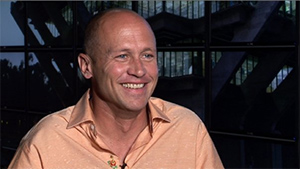|
Q & A with Mike Judge
Filmmaker and UC San Diego alumnus Mike Judge served as keynote speaker for the All Campus Graduation Celebration this weekend. He took a few minutes out to sit down with @UCSD editor Raymond Hardie.
Raymond Hardie | June 15, 2009

Mike Judge (Photos / Alex Matthews)
Hardie: In Office Space, Jennifer Anniston says: “I don’t really like talking about my flair.” Is that your attitude toward interviews?
Judge: (laughs) Hmm… Yeah, I don’t so much like talking about my flair I suppose. No, interviews can be OK, but I get a little weird talking about myself for too long. But I’ve got an ego like anybody else and I can go on about myself once in a while—and then I just regret it later.
Hardie: I read somewhere that when you went to UCSD you were interested in science and surfing. Where did you surf? And did you get much time to do it?
Judge: I actually did not surf when I was here. When I was in junior high in Albuquerque, land-locked, nowhere near a beach, I was hanging out in the library trying to make sure that I wouldn’t get my butt kicked. But when I came out here, I didn’t have a lot of money, I was living in the mesas and I ended up trying to surf just three or four times. I didn’t have a car or a board. I got into surfing later in life.
Hardie: What if anything did you learn in physics and/or UCSD that helped you in your career?
Judge: I don’t think you need to know physics to do animation, but there is a thing called squash and stretch that you do in animation — because the physics don’t look right. In a weird way, there is some physics of motion in animation. In themodynamics, you learn probability and statistics and, so, sometimes when the studio is trying to pull one over on me about the statistics of a test screening etc. I can just lecture them on how it really is and how unscientific they’re being.
Hardie: How did you get into animation from physics, surfing and rock music?
Judge: Animation is always something I wanted to try. I loved the way it looked. I always wanted to get a camera, do single frame and do claymation. I’d go to all these animation festivals. I just love the way it looks, projected. I also wanted to go into comedy, you know, like sketch comedy. I was embarrassed to tell anyone about that but it was something I had always wanted to try. And I didn’t really think it was a possibility for me. But what happened was that it all came together when the Animation Celebration, which played all over the world, played in Dallas at the Inwood Theater. And they had a local animator and they had his drawings. Suddenly, it just seemed like a possibility. I kind of hunkered down and bought a Bolex. I didn’t even have a computer I just started making animations. The first one I finished was called Office Space, it was just a home-made cartoon — just a guy at a desk.
Hardie: Where did Beavis and Butt-Head come from? What was the creative process? Did the voices come first?
Judge: Until Beavis and Butt-Head, which was the fourth animated short I’d done, it was usually the voice and soundtrack that came first. That is normally how you do it in animation. I’d do the voice and come up with the drawing to match it. Beavis and Butt-Head was the other way. I did the drawings and then I thought I should do something with these guys. They didn’t talk as much (he laughs). Milton, the first office space short, is just a monologue, just talking, which most people in animation hate because you have to time every syllable, and figure it all out. I kind of like doing that. I’m kind of weird that way.
Hardie: Tell me about some of the pressure that you felt during the heady days of Beavis and Butt-Head.
Judge: We did close to 200 episodes of Beavis and Butt-Head, but from the get-go it was really successful — although I don’t think I enjoyed the success until it was over. There was always something stressful about it. MTV are really nice folks but didn’t really know what they were doing. Nice folks this like gets ratings, so they want it on every day. But you can’t do an animation show every day — it’s just never been done. There was never a normal schedule of seasons. It was “do as many as you can possibly do and keep doing them.” And I was new to it and I wanted to be a good sport and I didn’t want to ruin my career before it got started, so I was working my butt off. And then there was all this controversy. I became the scapegoat for everything that people hated about TV. And then that ended up getting a lot of people defending it like David Letterman, Stephen King and Jerry Seinfeld saying it was really a good show. That was really nice and then the pressure started coming off. But it was always really a mixed bag.
Hardie: What advice would you give to a student arriving at UCSD today?
Judge: I don’t really have anything that brilliant to say to somebody who is a freshman now, but one thing I was saying to students before when they were asking me. I’ve seen so many people ruin their careers before they start by just being a jerk and not being nice, so, whatever you’re going to go into, if you can just be humble and nice and show up on time, you would be amazed how far that can get you — as well as being talented and well-educated.

|